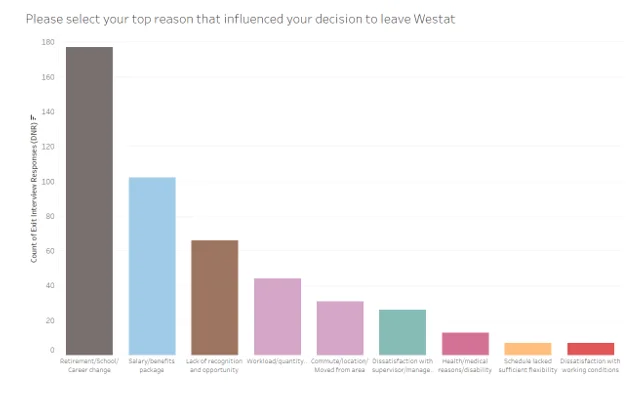- Problem Description:
- 1. Base Salary:
- 2. Manager Suggestions:
- 3. Management Policy:
- 4. Benefits:
- 5. Cooperation:
- 6. Recommend:
- Employee Exit Reasons:
- Conclusion:
In pursuit of elevating employee satisfaction at Westat, our analysis reveals key insights into demographic variations and discrepancies between exit and workplace satisfaction surveys. By addressing specific concerns related to compensation, recognition, and departmental differences, Westat can strategically enhance its workplace environment and foster long-term employee engagement and loyalty.
Problem Description:
The data analysis assignment involves a comprehensive analysis of survey data from both the Exit Survey and the Great Place to Work Survey at Westat. The primary focus is on understanding employee satisfaction across various categories such as Base Salary, Manager Suggestions, Management Policies, Benefits, Cooperation, and overall recommendations for Westat as a workplace. The solution provides insights into demographic variations and identifies potential discrepancies between the two surveys.
1. Base Salary:
- Employees aged 55 or older express higher satisfaction (3.97).
- Females score higher (3.23) than males (2.74).
- Frontline managers and AD & VP exhibit the highest satisfaction (5.00).
- White employees and those with over 20 years of tenure report higher satisfaction.
- Discrepancy noted between Exit Survey and Great Place to Work Survey on fair pay perceptions.
2. Manager Suggestions:
- Differences observed between Exit Survey and Great Place to Work Survey scores.
- Varied scores across demographic groups and departments.
- Notable distinctions in scores for race/ethnicity and tenure categories.
3. Management Policy:
- Positive feedback on management following policies in Exit Survey (4.38 to 5.00).
- Great Place to Work Survey addresses honesty and ethics more broadly.
- Notable differences in specific items and scores between the surveys.
4. Benefits:
- Differences in scores for "Medical/Health" benefits between Exit Survey and Great Place to Work Survey.
- Specific demographic variations observed in both surveys.
- Difficulty in drawing direct comparisons due to varied survey focuses.
5. Cooperation:
- Positive perceptions in both surveys regarding cooperation and teamwork.
- Varied scores across age groups, genders, managerial levels, and departments.
6. Recommend:
- Comparison of responses on recommending Westat as a workplace.
- Varied scores across age groups, genders, managerial levels, race/ethnicity, tenure, and departments.
- Great Place to Work Survey generally indicates higher recommendation scores.
Employee Exit Reasons:
- Retirement, pursuing further education, or career change prominent reasons for leaving.
- Majority leave due to dissatisfaction with salary and benefits, and lack of recognition and opportunity.
- Recommendations for Westat to address compensation concerns, provide growth opportunities, and enhance recognition.

Figure 1: Analysis of survey data for exit interview responses
Conclusion:
The analysis highlights areas of employee satisfaction and potential discrepancies between the Exit Survey and Great Place to Work Survey. Recommendations emphasize addressing compensation and recognition concerns for improved employee retention. Further analysis, such as exit interviews, can provide deeper insights for proactive improvements.
More Samples
Explore a wealth of statistical survey samples showcasing diverse methodologies and analyses. Dive into our curated collection to glean insights into survey design, data collection, and interpretation techniques. Discover practical examples elucidating the intricacies of statistical surveying processes.
Statistical Survey
